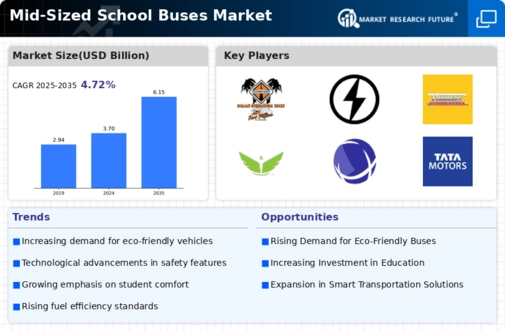Market Growth Projections
The Global Mid-Sized School Buses Market Industry is poised for substantial growth, with projections indicating a market value of 3.7 USD Billion in 2024 and an anticipated increase to 6.15 USD Billion by 2035. This growth trajectory suggests a compound annual growth rate of 4.72% from 2025 to 2035, reflecting the increasing demand for mid-sized school buses. Factors contributing to this growth include rising safety standards, government funding initiatives, and technological advancements in bus design. As educational institutions continue to prioritize student safety and environmental sustainability, the market is likely to expand, presenting opportunities for manufacturers and stakeholders in the industry.
Government Initiatives and Funding
Government initiatives play a pivotal role in shaping the Global Mid-Sized School Buses Market Industry. Various federal and state programs provide funding and incentives for schools to purchase environmentally friendly and efficient transportation options. For example, the Clean School Bus Program aims to replace older diesel buses with cleaner alternatives, thereby promoting sustainability. This initiative not only enhances air quality but also aligns with the growing emphasis on reducing carbon footprints in the education sector. As a result, the market is expected to witness significant growth, with projections indicating a rise to 6.15 USD Billion by 2035, driven by these supportive policies.
Focus on Environmental Sustainability
The Global Mid-Sized School Buses Market Industry is increasingly influenced by a focus on environmental sustainability. Schools and districts are actively seeking to reduce their carbon emissions and environmental impact by transitioning to greener transportation options. This shift is evident in the growing interest in electric and hybrid mid-sized school buses, which offer lower emissions compared to traditional diesel models. As governments and educational institutions prioritize sustainability, the market is likely to expand significantly. The projected growth to 6.15 USD Billion by 2035 underscores the potential for eco-friendly buses to become a standard in school transportation, aligning with global sustainability goals.
Technological Advancements in Bus Design
Technological advancements are transforming the Global Mid-Sized School Buses Market Industry, leading to the development of more efficient and user-friendly vehicles. Innovations such as improved fuel efficiency, advanced safety systems, and integrated communication technologies are becoming standard features in new models. For instance, the incorporation of GPS tracking and real-time monitoring systems enhances operational efficiency and safety. These advancements not only attract school districts looking to modernize their fleets but also contribute to the overall growth of the market. As schools increasingly recognize the benefits of these technologies, the market is likely to experience a compound annual growth rate of 4.72% from 2025 to 2035.
Increasing Demand for Safe Transportation
The Global Mid-Sized School Buses Market Industry experiences a growing demand for safe and reliable transportation solutions for students. As educational institutions prioritize student safety, the adoption of mid-sized school buses, which offer enhanced safety features, is on the rise. For instance, many jurisdictions are implementing stricter regulations regarding vehicle safety standards, which encourages schools to invest in newer models. This trend is reflected in the projected market value of 3.7 USD Billion in 2024, indicating a robust interest in upgrading existing fleets to meet safety requirements. Consequently, the market is likely to expand as schools seek to ensure the well-being of their students during transit.
Rising Enrollment in Educational Institutions
The Global Mid-Sized School Buses Market Industry is positively influenced by the rising enrollment rates in educational institutions worldwide. As more students enroll in schools, the demand for transportation solutions increases correspondingly. This trend is particularly evident in urban areas where population growth drives the need for efficient school transportation. Schools are compelled to expand their fleets to accommodate the growing number of students, thereby boosting the market for mid-sized buses. The anticipated growth in enrollment figures suggests that the market will continue to thrive, with a projected value of 6.15 USD Billion by 2035, reflecting the ongoing need for effective transportation solutions.










